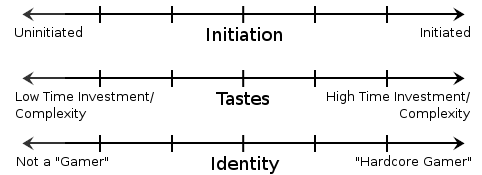- Wondering how to get Monopoly GO! free rolls? Well, you’ve come to the right place. In this guide, we provide you with a bunch of tips and tricks to get some free rolls for the hit new mobile game. We’ll …
Best Roblox Horror Games to Play Right Now – Updated Weekly
By Adele Wilson
Our Best Roblox Horror Games guide features the scariest and most creative experiences to play right now on the platform!The BEST Roblox Games of The Week – Games You Need To Play!
By Sho Roberts
Our feature shares our pick for the Best Roblox Games of the week! With our feature, we guarantee you'll find something new to play!All Grades in Type Soul – Each Race Explained
By Adele Wilson
Our All Grades in Type Soul guide lists every grade in the game for all races, including how to increase your grade quickly!
Core and Casual: What Are We Talking About? (Part 1 of 4)
The games industry has a dirty secret. We hold press conferences and give keynote speeches, put up billboards in Times Square and displays in 7-Elevens. On stage, online, and in every message that reaches public ears, we declare our steadfast dedication to making “core” games, or announce our bold decision to explore “casual” games. Yet in reality this is a dishonest message because every good game creator knows that there has never been a successful game that was either exclusively “core” or exclusively “casual.”

The games industry has a dirty secret. We hold press conferences and give keynote speeches, put up billboards in Times Square and displays in 7-Elevens. On stage, online, and in every message that reaches public ears, we declare our steadfast dedication to making “core” games, or announce our bold decision to explore “casual” games. Yet in reality this is a dishonest message because every good game creator knows that there has never been a successful game that was either exclusively “core” or exclusively “casual.”
The problem stems from the popular notion that there are two discrete groups of people in the world: casual gamers and core gamers. When someone loosely refers to “casual gamers,” we all smile and nod our heads as though we know the specific group of people they’re talking about. Still, like all labels used to define large groups of people, this system quickly breaks down. At a recent press event, Microsoft caused many of its loyal fans to feel betrayed and alienated, largely due to a few misguided statements that relied heavily on this assumed difference between “core” and “casual” players. More on that later.

Surely, though, there must be some inherent truth to the core/casual divide that makes it so easy to grasp. The first solution is to stop assuming that the world is in black and white – if the original Game Boy could produce two additional shades of gray, then surely people and gamers must come in a few more. If we cease thinking of casual/core as a binary trait, and picture our players as existing on a number line somewhere between casual and core, we can pat ourselves on the back for not dealing in stereotypes, and we get a mental image like this:

Uh oh! There we go alienating people again! Here I’ve gone and trivialized the “casual” players as being somehow “less” than the “hardcore” players – and look, I’ve already fallen back on dividing the number line in two and regarding some of my players as hardcore and some of them as casual. Despite my best efforts, I’m already subconsciously placing the God of War players on the right-hand extreme and the Bejeweled players on the left. What’s worse, I have no clue where to place my World of Warcraft-addicted friends, or the folks I know that still logged a few hours of Wii Sports every day, long after most people had lost interest. Clearly this system still needs work.
Labels can be helpful, but only in the proper context. No person is entirely a casual or core gamer, nor can you define them as “50% casual, 50% core.” These terms can only make sense if we are trying to identify the audience of a particular game. For instance, a game designer working on a pet-raising sim would ask, “What people belong to this game’s core audience, and what people might belong to this game’s casual audience?” and try to optimize their game to appeal to both groups. The “core audience” for their virtual pet game is probably not the same group as the “core audience” for an action game set during World War II. All of a sudden, the terms become a lot more meaningful, because they define a player’s relationship to a particular game, not to “gaming” in general.
We’re still not out of the woods, though, because we’ve left our hypothetical designer hanging. The question was “What people belong to this game’s core audience, and what people might belong to its casual audience?” How do we even know what these terms mean? At this point in our little exercise, we might all think we have a clear sense of who Game X’s casual and core players are, but this is no less a mistake than it was before. Even with respect to one particular game, how do you define “casual” and “core”?
We think that we all know and agree on what makes a player “casual” and what makes them “core,” but it turns out we could be one of several different things. I think I’ve reduced it down to three – three different axes on which a player sits. Three attributes that exist on their own independent scales, all of which we’ve become accustomed to measuring with the terms “casual” and “core.” Right off the bat, let’s give these attributes different names, to avoid confusion’: Initiation, Taste, and Identity. These are distinct characteristics, yet we often conflate them, doing a disservice to our games and their audiences.

Vincent St. John is an alumnus of The College of New Jersey where he majored in Computer Science, studied Interactive Multimedia, considered musical theater, and even passed one class in world history. When he is not being an armchair games critic, Vincent develops marketing strategies for social games developer Arkadium in New York.
More articles...
Monopoly GO! Free Rolls – Links For Free Dice
By Glen Fox
Wondering how to get Monopoly GO! free rolls? Well, you’ve come to the right place. In this guide, we provide you with a bunch of tips and tricks to get some free rolls for the hit new mobile game. We’ll …Best Roblox Horror Games to Play Right Now – Updated Weekly
By Adele Wilson
Our Best Roblox Horror Games guide features the scariest and most creative experiences to play right now on the platform!The BEST Roblox Games of The Week – Games You Need To Play!
By Sho Roberts
Our feature shares our pick for the Best Roblox Games of the week! With our feature, we guarantee you'll find something new to play!All Grades in Type Soul – Each Race Explained
By Adele Wilson
Our All Grades in Type Soul guide lists every grade in the game for all races, including how to increase your grade quickly!







